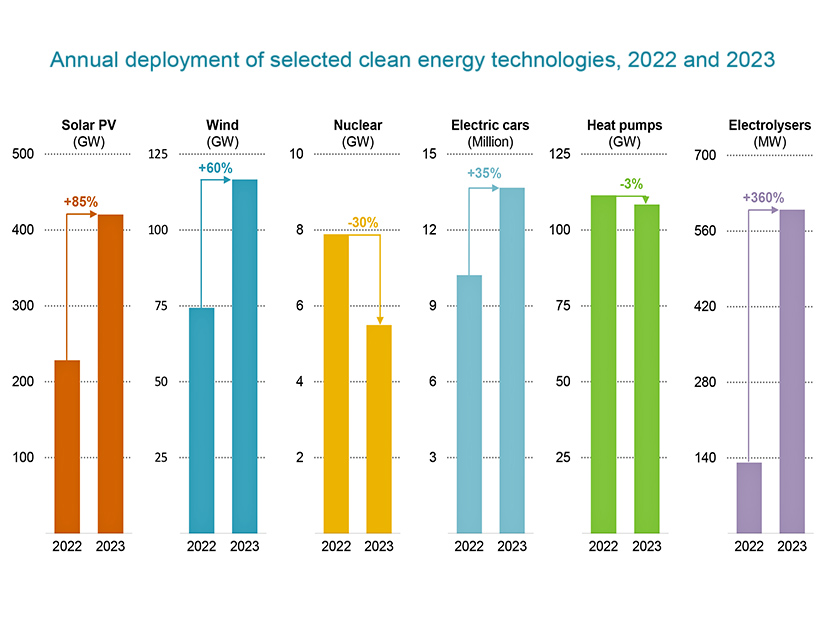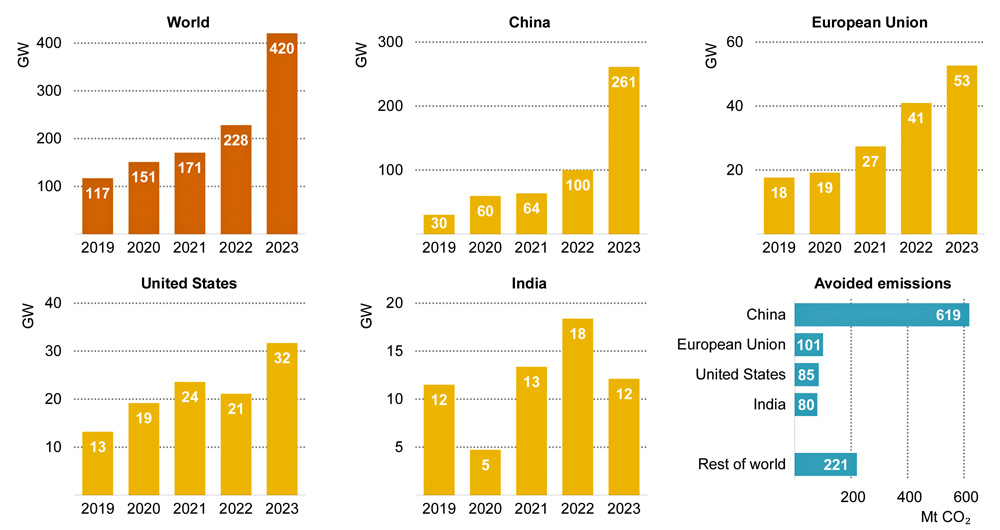
The International Energy Agency reports that worldwide CO2 emissions hit a record in 2023 but would have climbed even higher without the rapid adoption of clean technology.
The year-over-year emissions growth in 2023 was not as great as in 2022, IEA said, even as the growth in energy demand accelerated. Over the past five years, IEA added, clean energy generation capacity increased at twice the rate of fossil generation.
The analyses come in the 2023 edition of IEA’s annual CO2 emissions update and in the inaugural edition of its new “Clean Energy Market Monitor.”
Combined, the two reports attach new statistics and details to trends that have been observed in recent years. Takeaways include:
-
- Global CO2 emissions increased by 410 million tons in 2023, reaching 37.4 billion tons; this compares with a 490-million-ton increase in 2022.
- Advanced economies saw a record decline of emissions in 2023 as low-emitting resources accounted for half of their electric generation; their emissions dropped to a 50-year low, and their use of coal dropped to a 120-year low.
- This is because clean energy continues to be largely concentrated in advanced economies and China; in 2023, they accounted for 90% of new solar and wind generation and 95% of electric vehicle sales.
- Clean energy has become a major industrial sector and an important part of the world economy; investment has been growing 10% annually and totaled $1.8 trillion in 2023 alone.
- China continued its rapid buildout of clean-energy technology in 2023, adding 64% more solar capacity than the rest of the world combined and leading every other metric except nuclear. But China also ratcheted up fossil fuel consumption in 2023 as it continued its post-pandemic recovery and saw hydropower generation decrease by 125 TWh. The overall emissions increase was estimated at 565 million tons.
- The United States decreased CO2 emissions from energy combustion by 4.1%, even as its economy grew 2.5% and hydropower and wind power output declined; the coal-to-gas transition was the largest factor.
- By contrast, coal demand in emerging and developing economies was the largest driver in the worldwide increase in CO2 emissions.
- Extreme drought curtailed hydropower output in multiple regions in 2023; the use of fossil fuel as a replacement accounted for more than 40% of the worldwide increase in emissions.
- In countries with large energy demand for indoor temperature control, the 2023 heating season was much milder than 2022, but the 2023 cooling season was not much hotter, yielding a 120-million-ton net year-over-year reduction in emissions.
- Heat pump sales dropped marginally in 2023, which is attributed to consumer hesitance on large purchases.
- Hydrogen electrolyzer capacity increased 360% in 2023, but that was from a low starting point.
In a news release accounting the reports, IEA Executive Director Fatih Birol said: “The clean energy transition has undergone a series of stress tests in the last five years — and it has demonstrated its resilience. A pandemic, an energy crisis and geopolitical instability all had the potential to derail efforts to build cleaner and more secure energy systems. The clean energy transition is continuing apace and reining in emissions — even with global energy demand growing more strongly in 2023 than in 2022.”
But the transition needs to extend beyond the handful of leading economies, Birol added: “We need far greater efforts to enable emerging and developing economies to ramp up clean energy investment.”
Statistics in the “CO2 Emissions in 2023” report are based on IEA analysis of energy, economic and weather data about carbon dioxide emissions from energy combustion and industrial processes. The “Clean Energy Market Monitor” relies on data from national sources and industry associations.


